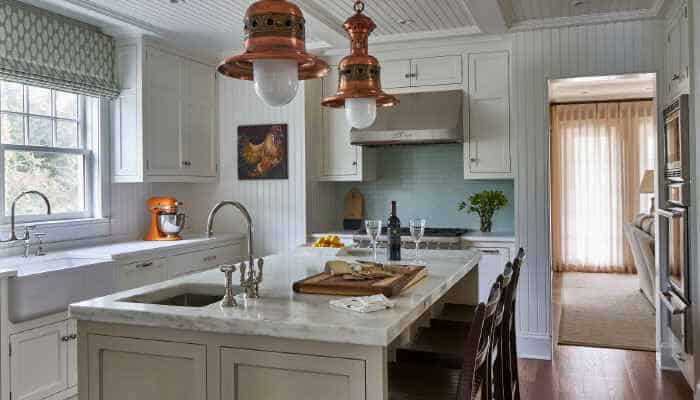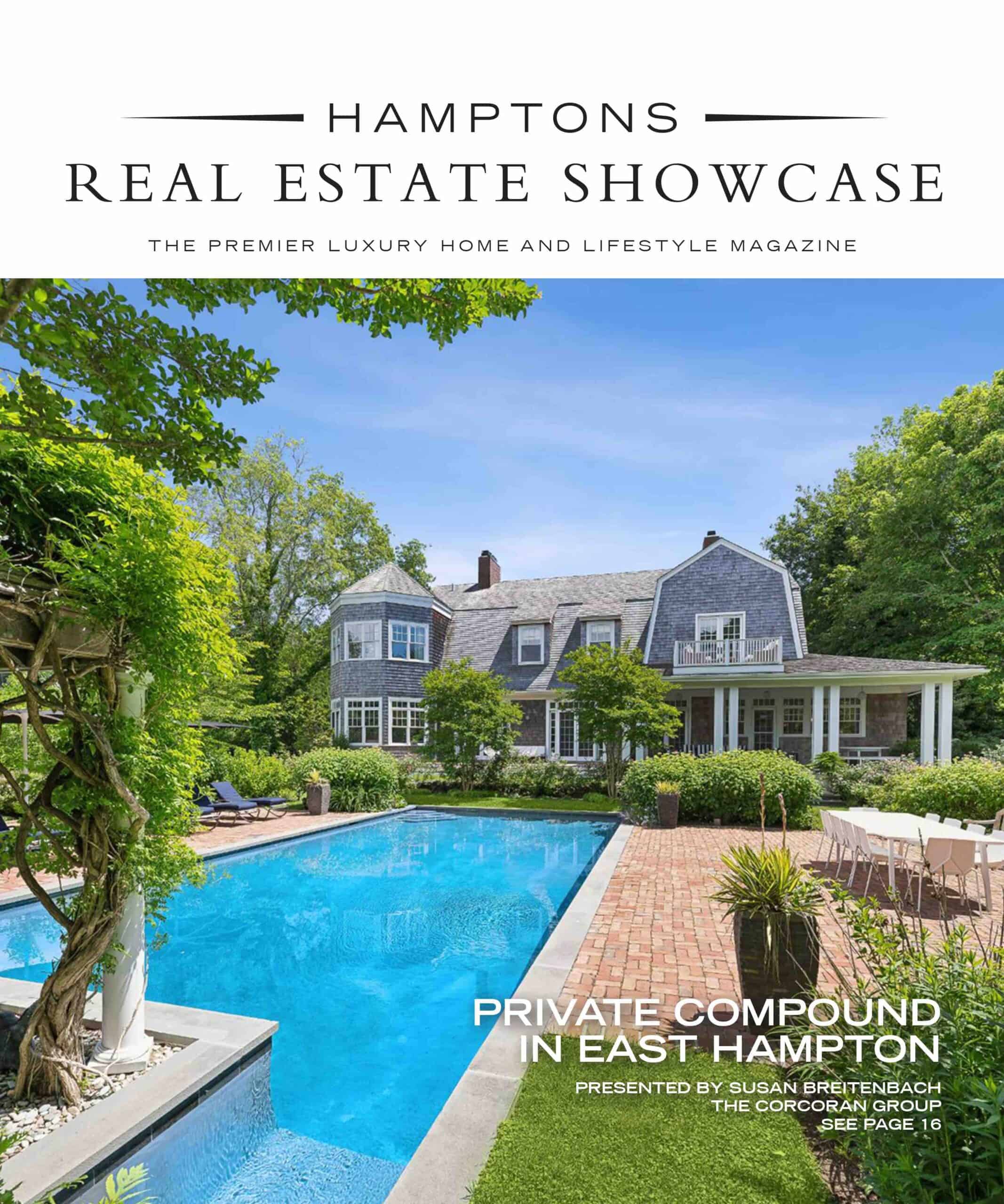The preservation of historic homes is a delicate business. The goal, as the architecture critic Paul Goldberger once put it, is “not to bring us back to another time but to enrich the experience of our own time.” Something of that sensibility informs the residential work of Brian Brady, a Southampton architect and designer whose houses are a graceful marriage of past and present.
For Brady, who worked for I.M. Pei and other greats before establishing his own practice, it’s all about the classical values of scale and proportion. Therefore his homes don’t flaunt Modernist protrusions from them. They don’t draw attention to themselves. Brady wants the structures he designs to look, he says, as if they’ve been standing for a hundred years.

A case in point is a Shingle-style cottage on Elm Street in Southampton which you may have passed without noticing. When the current owners, a retired couple with two adult children and grandchildren, commissioned him to renovate the 3,000-square-foot house and design its interiors, the place was in rough shape. Built in 1919, the cottage was, in Brady’s words, “a relic.”
“There were bad additions, but the place had great bones,” he recalls. “High ceilings, a nice deep lot.” His brief was to create a spacious family compound on the grounds without changing the existing façade.

Brady’s solution was to lift the house, a move that allowed him to increase its square footage while setting it on a proper foundation. By installing tall light wells in the new space, he effectively converted what used to be the basement into sun-drenched guest quarters. Through this intervention the client gained almost 1,800-square-feet. (Basements, Brady explains, aren’t taken into account in Southampton zoning laws.)

In the rear of the house, he added an enormous kitchen and a family room. And just above those rooms, on the second floor, he created a new master suite. Although you can’t see it from the curb, there’s an old barn on the property, which Brady preserved. He also built an adjoining carriage house with a gym and a pool house that doubles as a playroom for the grandchildren.
Once the structural work was complete, Brady turned his attention to the cottage’s interiors. Originally from New England, the clients wanted their home to take its stylistic bearings from Nantucket rather than the Hamptons. To achieve that look, Brady and his team brought in English and early American antiques which they sourced at flea markets and from dealers across the country so that the furniture would look as though it had aged with the home.

“We like to use found pieces to add character,” he notes. On the character-instilling front, the design team painted the inside of an oak cabinet in robin’s egg blue and designed custom-made furniture from reclaimed wood, including a built-in hutch that looks as though it might have been there all along. Brady also used to good advantage such period details as bead board, coffered ceilings, and hardwood beams. The early Americana motif is leavened by the clients’ collection of African art which features prominently throughout the house. Overall, the effect is so natural you might assume the family had lived there for years, enriched by faint whispers of the past and also the experience of their own time.
Brady Design | bradydesign.com












![Treat yourself to an unforgettable evening this Sunday, November 17th, at @sensagharbor 🍣🍸 Indulge in chef-curated courses featuring luxurious caviar, rich Wagyu beef, and perfectly paired wines from @paumanokvineyards. A night of indulgence and elegance awaits—don’t miss this exclusive culinary experience! [link in bio]](https://hamptonsrealestateshowcase.com/wp-content/uploads/sb-instagram-feed-images/467184544_1766493134164226_6024859026051554135_nfull.webp)
![Homeowners are faced with the daunting task of choosing the right kitchen design — one that will remain timeless for both entertaining and day-to-day functionality. With a focus on luxury, clients are increasingly leaning towards clean, modern aesthetics but are hesitant to embrace a fully contemporary look. [link in bio]](https://hamptonsrealestateshowcase.com/wp-content/uploads/sb-instagram-feed-images/467244043_1082221510295882_2208387561574057218_nfull.webp)
![Experience the epitome of coastal country living in this newly constructed, quality craftsmanship waterfront home on James Creek, leading to Peconic Bay. With 80± ft. of prime waterfront, 4060 Ole Jule Lane showcases thoughtfully landscaped grounds, a bluestone patio, outdoor shower, and a refreshing saltwater pool. Represented by @nataliealewis of @coldwellbanker. [link in bio]](https://hamptonsrealestateshowcase.com/wp-content/uploads/sb-instagram-feed-images/467188671_18474458155030135_7164624532118372206_nfull.webp)
![Welcome to 122 Mill Pond Lane, an impeccably conceived and meticulously maintained residence in a dramatic west-facing setting on Mill Pond. Throughout the home are thoughtfully considered elements that reinforce the home’s clean, modern sensibility. Represented by @kraelyllahamptons of @hamptonsrealestate. [link in bio]](https://hamptonsrealestateshowcase.com/wp-content/uploads/sb-instagram-feed-images/466787127_18474263443030135_2753720635361764689_nfull.webp)

![Perched atop the dunes at Louse Point sits 2 picturesque homes at 88 & 86 Louse Point Road, both perfect for enjoying all seasons that East Hampton has to offer. Each thoughtfully designed home maximizes the topography to allow seamless indoor/outdoor living and entertaining. Represented by @petrieteam of @compass. [link in bio]](https://hamptonsrealestateshowcase.com/wp-content/uploads/sb-instagram-feed-images/466619407_18473886082030135_7330054085188815713_nfull.jpg)
![Get cozy every Friday at Canoe Place Inn! 🍫🔥 Gather around the fire on our Garden Lawn for Fireside Fridays all season long, where evenings are warmed up with hot cider, hot chocolate, s’mores, and cocktails. Enjoy live acoustic music on select dates, and with your first drink, receive a complimentary s'mores kit! [link in bio]](https://hamptonsrealestateshowcase.com/wp-content/uploads/sb-instagram-feed-images/466374901_1761070534297706_6837753985329213061_nfull.jpg)
![Musical Superstar and Sag Harbor resident Billy Joel has listed his 26± acre Long Island estate for $50M. Assembled over time on adjoining parcels, the Centre Island compound features a 20,000± sq. ft. main home plus several additional structures—all with access to 2,000± ft. of private shoreline boasting a dock and a boat ramp. [link in bio]](https://hamptonsrealestateshowcase.com/wp-content/uploads/sb-instagram-feed-images/465973748_18473309701030135_6935355293028123088_nfull.jpg)
